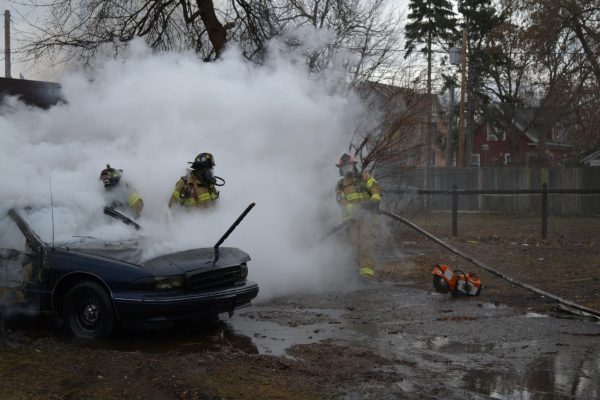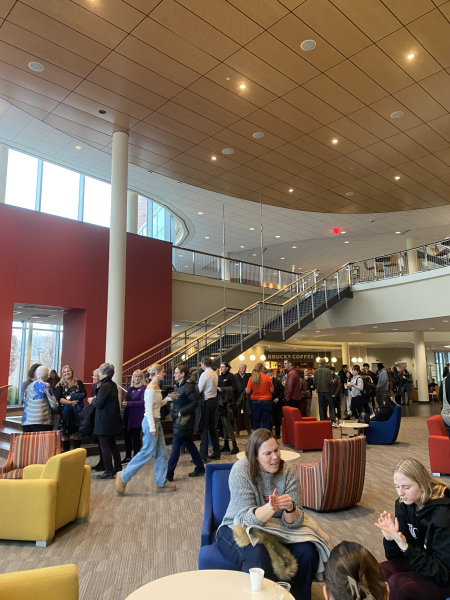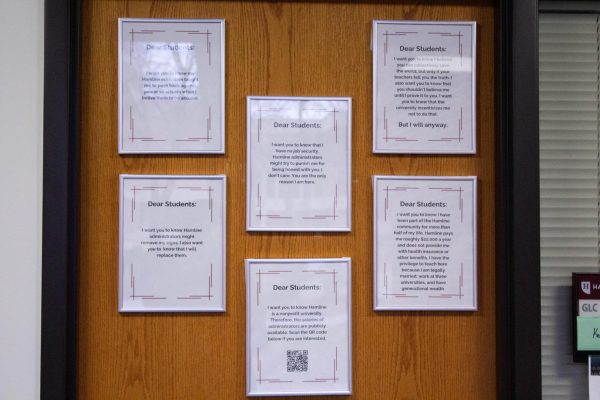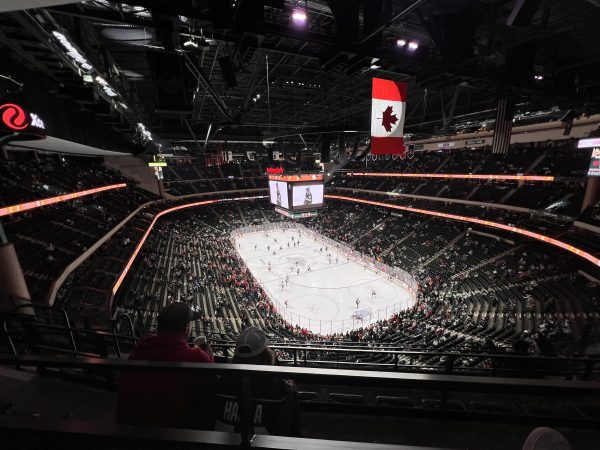Trash Talk
April 18, 2023
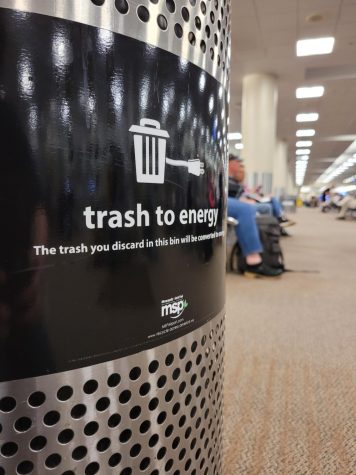 We do not always consider the long-term consequences when we throw things away. When trash ends up in landfills, it can produce emissions such as methane. When waste ends up in the water, it pollutes ecosystems and endangers aquatic life. When the trash is burned, the pollutants cause health problems in nearby communities. Through interviews with Hennepin County’s Ben Knudson and Joseph M Vital from the Hennepin Energy Recovery Center (H.E.R.C.), I attempted to dig deeper into the matter and understand how we can solve the problem.
We do not always consider the long-term consequences when we throw things away. When trash ends up in landfills, it can produce emissions such as methane. When waste ends up in the water, it pollutes ecosystems and endangers aquatic life. When the trash is burned, the pollutants cause health problems in nearby communities. Through interviews with Hennepin County’s Ben Knudson and Joseph M Vital from the Hennepin Energy Recovery Center (H.E.R.C.), I attempted to dig deeper into the matter and understand how we can solve the problem.
When We Waste
People and companies in Hennepin County produce 1.3 million tons of waste per year, which is an estimated six pounds of trash per day per person! So where are we supposed to put all of this garbage? In Hennepin County, much of this waste is sent to the Hennepin Energy Recovery Center which incinerates waste to produce electricity. The rest of the waste is sent to landfills in other counties. Is this something that works? Is this the best way to handle our trash problem? According to many environmental activist organizations, this is far from the best solution.
Based on information from the Minnesota Center For Environmental Advocacy, and other reviewers it is far from being the solution we seek to our garbage problem. Burning garbage can often create pollution that is bad for the environment. These facilities are typically placed closer to neighborhoods that predominantly hold people of color or lower income housing. Landfills are not a viable option either because it really just contributes to the destruction of native ecosystems, greenhouse gas emissions, water pollution and more. As observed by the University of Colorado, people of color and people living in low-income neighborhoods are disproportionately impacted by the negative effects of landfills and garbage facilities.
One idea currently under research is the “Anaerobic digestion” of organic waste that makes up 25-35% of our trash. This will allow bacteria to consume a large percentage of our trash with the potential of creating future fuel sources. This option is currently being researched in California and Canada. Ultimately, though, diversion is always the most proffered priority.
According to the Minnesota Pollution Control Agency, two-thirds of our trash that is incinerated in locations such as the HERC facility or placed into landfills could have been composted, recycled or even used for a longer period of time. 519,400 tons of food waste could have been composted across the state of Minnesota alone. Ultimately, the most important and resounding message across multiple communities is to create Zero-Waste plans focused on diverting waste. Colleges such as Macalester are already in the process of doing their part.
“It takes action at every level”
Hennepin and Ramsey counties both establish various means of infrastructural support to reduce waste before it hits the garbage can. The preference is always to conduct the three R’s first: Reduce, Reuse and Recycle.
Knudson mentions that counties, the hidden layer of government, try to provide recycling and composting programs, and pay for programs and education outreach (ESP for cities) for waste management that fit under the guidelines of the Zero Waste challenge. 44 cities in Hennepin County have a designated coordinator meant to improve and increase meaningful communication within their communities. Some of the infrastructural support comes in the form of Fix-it clinics that help you repair your items and/or appliances to extend their use before being thrown away. It also gives the benefit of creating a “Culture of self-reliance” within the community, who doesn’t want that?
“It takes action at every level,” Knudson states “one person, one action.” This can be reflected in our individual waste management and shopping habits, though the currently existing infrastructure can create a barrier for many people.
To start, the process of reducing waste can feel overwhelming, most people do not know where or how to learn more about composting in the right ways. Going to grocery stores creates a waste challenge because everything is in a cardboard box or uses single-use plastics. Some grocery stores such as the Tare Market strive to address this challenge, though it can be difficult for college students to find reliable transportation to zero-waste grocery sources.
When it comes to combating companies without environmental interests or finding the necessary funding to support improved zero-waste infrastructure, we often must look to state and federal government entities to pass legislative work; as constituents, we have a say in legislative priorities to encourage bills to pass more quickly and effectively.
One form of legislation that has been of curiosity and interest in the past in Minnesota is “Bottle Bills,” which would pay people to return their plastic bottles to the stores where they bought them. In the state of Iowa, everyone across the state gets five cents a bottle. Not everyone cares about five cents. According to the Container Recycling Institute, states with Bottle Bills often have higher recycling rates than states without. This can be especially crucial for rural communities that lack any of the necessary materials or resources. Until then, what can we do?
Reduce
Purchase or take only what you need and know you will use; reduce how much grows in the garbage by realistically evaluating your own consumption habits. When you do make purchases, try to purchase items that produce minimal waste.
Some ways of implementing this into your day-to-day life may mean bringing reusable containers to a low or zero-waste grocery store when possible, and utilizing reusable cloth grocery bags instead of collecting more plastic bags over time. This can be difficult for many people because packaging choices are more “upstream” because companies and stores rely on the packaging.
Transformational change will be necessary to truly address this problem and create a more sustainable and long-term solution for everyone. When you can, it is always good to be aware of zero waste stores such as the Tare Market or farmer’s markets. Here is a helpful guide to finding more reduced waste places to shop. Don’t forget to bring your own reusable containers and shopping bags!
Reuse
There are many ways to expand our daily lives to include this necessary goal. When you go shopping, it is worth making your first stop at a local thrift or second hand store to extend the life of your clothing.
When you are ready to part with your clothing or old furniture, there are many ways to part with them in an environmentally friendly way. Consider selling or trading your items or clothing on buy nothing groups or Facebook Marketplace. It may be worth dropping off or ordering a pick up of your larger items from your local second-hand stores such as the Habitat for Humanity ReStore or a local nonprofit organization such as Bridging. Don’t forget that stores such as Plato’s Closet often buy gently used clothing, as if you really needed another incentive.
Don’t forget that laptops can be refurbished for continued use by recycling organizations such as FreeGeek which provides low-cost repaired electronics. Consider these options when you start your spring cleaning!
What if the problem is different though? What if you want to throw something away because it is in a run-down condition and you or anyone will not be able to use it anymore? It still does not have to go to the heat abyss or a landfill if you take it to a Fix-it clinic hosted by Ramsey or Hennepin Counties. Fix-it clinics provide additional buttons, repair support, or supplies needed to fix your items to continue their use.
Extending the life of your clothing and items is just as important as where you bought them from the start. It may even be worth asking yourself if it is time for students to come together to host Fix-it clinics on campus.
Recycle
Almost everyone and their mother are familiar with recycling these days, but how much? A high amount of contaminated recycling results in sorted items being thrown away in the garbage anyways because there are not enough resources or willing manpower to clean recycling after it has reached its designated location.
One of the most important ways of addressing this issue is through Recycling Ambassadors involved in county-wide programs (Ramsey, Hennepin) who provide peer-to-peer messaging to people within their own communities. Having a meaningful messenger can make all the difference in increasing resource opportunities (such as grants), reducing disparities and extending or exposing the reach of programs that are already available. It is times like these when the “Messenger Really Matters.”
Plastic and paper are not the only noteworthy recyclables within Ramsey and Hennepin County.
Some programs are available including electronics recycling through organizations such as RePowered and FreeGeek (mentioned previously).
Unfortunately, E-recycling comes at an expense that many people do not wish to shoulder, especially for larger items. Hopefully, there will be long-term solutions to this particular problem fairly soon. Joseph M Vital of the Hennepin Energy Recovery Center has recovered 11 million tons of scrap metal from the HERC facility and an additional 60,000 tons of metal from the landfills after incineration. Given how valuable and recyclable metal is, this statistic is of a particular shock to me.
Other diversion methods
After all of these steps, there is still so much leftover and many of my readers may be wondering “So what do I do with the rest?”
To start, let’s look at your hazardous materials; leftover propane and aerosols should not be thrown away with the rest of your trash in the first place, it must be taken to a Household Hazardous Waste collection site within your county (Hennepin, Ramsey). This not only reduces the automatic risk of harm but also reduces potential contamination in the future.
Another important diversion method is Compost. The topic of composting is very important and will take much longer to discuss than I will go into here. Put most simply: set organic waste aside to be sent to a collection site, or set up a compost bin in your own backyard with some worms to produce some healthy and nutritious soil for your gardens in the future!
Compost produces no methane compared to the emissions you often find from decomposition matter within landfills, and this is a great way to reduce your carbon footprint.
Students discuss the Barriers
- “Some barriers to being zero waste; the first thing that comes to mind could be cost. Some of these zero-waste alternatives can be pricey because the demand is not high. I do know that some swaps can be free so that’s a good start. Also, social media and the promotion of fast fashion can contribute to the huge waste we see. A lot of our food is covered in plastic which is very wasteful and usually not recyclable since we don’t have enough resources yet…I should add that zero waste is a journey and it doesn’t happen overnight. Companies need to jump on board!” – Anjani White
- “One thing I was just annoyed at was plastic bags and like how stores don’t quite encourage the use of reusable bags (like I know in Europe they would charge for getting a plastic bag). These plastic bags are difficult to recycle (I think) and usually I would opt for paper bags if possible because most are compostable. I always get disgusted at the plastic bag collection at my house and how it would never go away.” -Ellie Erickson

